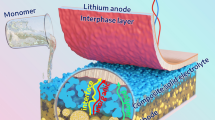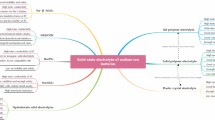Abstract
Sodium electrochemical energy storage systems including sodium-ion battery and hybrid capacitor are attracting increasing interest in large-scale electrical energy storage due to low cost and abundant sodium resources. In particular, sodium-ion hybrid capacitor with the merits of high energy and power densities as a typical next-generation energy storage device provides a promising alternative to the currently commercial lithium-ion battery. It is highly challenging to design and prepared suitable anode materials with extraordinary performance, thereby spurring its large-scale application. Herein, mesoporous Mn-doped and carbon-coated NaTi2(PO4)3 nanocrystals are synthesized via a three-step process of solvothermal reaction, serum albumin decoration and thermal annealing. Synergistic effect rendered by NaTi2(PO4)3 particles with mesoporous structure, Mn2+ doping and ultra-thin carbon coating endows the prepared composite with facile ion/electron transportation as well as excellent reaction kinetics as an anode material for sodium-ion hybrid capacitors. In the half-cell tests, the prepared composite exhibits high reversible capacity of 116 mA h g−1 at 1 C, high-rate capability of 95 mA h g−1 at 50 C, and long-term cycling stability with high capacity of 92 mAh g−1 (88% capacity retention) after 1000 cycles at 20 C. Using the prepared composite as anode and activated carbon as cathode, the sodium-ion hybrid capacitor is assembled and it exhibits high energy/power density of 85.5 WhKg−1/5531 WKg−1. Our results indicate that Mn-doped and carbon-coated NASICON-type anodes have great potential in the sodium-based electrochemical energy storage systems.







Similar content being viewed by others
References
J.B. Goodenough, K.-S. Park, The Li-ion rechargeable battery: a perspective. J. Am. Chem. Soc. 135, 1167–1176 (2013)
P. Simon, Y. Gogotsi, Nanoscience and technology: a collection of reviews from nature journals, world scientific, in Materials for Electrochemical Capacitors, ed. by P. Rodgers (Macmillan publishers, UK, 2010), pp. 320–329
Q. Wang, J. Yan, Z. Fan, Carbon materials for high volumetric performance supercapacitors: design, progress, challenges and opportunities. Energy Environ. Sci. 9, 729–762 (2016)
Y. Wang, Y. Song, Y. Xia, Electrochemical capacitors: mechanism, materials, systems, characterization and applications. Chem. Soc. Rev. 45, 5925–5950 (2016)
C. Liu, F. Li, L.P. Ma, H.M. Cheng, Advanced materials for energy storage. Adv. Mater. 22, E28–E62 (2010)
M.D. Slater, D. Kim, E. Lee, C.S. Johnson, Sodium-ion batteries. Adv. Funct. Mater. 23, 947–958 (2013)
L. Croguennec, M.R. Palacin, Recent achievements on inorganic electrode materials for lithium-ion batteries. J. Am. Chem. Soc. 137, 3140–3156 (2015)
H. Li, L. Peng, Y. Zhu, X. Zhang, G. Yu, Achieving high-energy-high-power density in a flexible quasi-solid-state sodium ion capacitor. Nano Lett. 16, 5938–5943 (2016)
M. Salanne, B. Rotenberg, K. Naoi, K. Kaneko, P.-L. Taberna, C.P. Grey, B. Dunn, P. Simon, Efficient storage mechanisms for building better supercapacitors. Nature Energy 1, 16070 (2016)
G. Yu, X. Xie, L. Pan, Z. Bao, Y. Cui, Hybrid nanostructured materials for high-performance electrochemical capacitors. Nano Energy 2, 213–234 (2013)
V. Aravindan, J. Gnanaraj, Y.-S. Lee, S. Madhavi, Insertion-type electrodes for nonaqueous Li-ion capacitors. Chem. Rev. 114, 11619–11635 (2014)
X. Han, P. Han, J. Yao, S. Zhang, X. Cao, J. Xiong, J. Zhang, G. Cui, Nitrogen-doped carbonized polyimide microsphere as a novel anode material for high performance lithium ion capacitors. Electrochim. Acta 196, 603–610 (2016)
Y. Ma, H. Chang, M. Zhang, Y. Chen, Graphene-based materials for lithium-ion hybrid supercapacitors. Adv. Mater. 27, 5296–5308 (2015)
P. Wang, R. Wang, J. Lang, X. Zhang, Z. Chen, X. Yan, Porous niobium nitride as a capacitive anode material for advanced Li-ion hybrid capacitors with superior cycling stability. J. Mater. Chem. A 4, 9760–9766 (2016)
R. Wang, J. Lang, P. Zhang, Z. Lin, X. Yan, Fast and large lithium storage in 3D porous VN nanowires-graphene composite as a superior anode toward high-performance hybrid supercapacitors. Adv. Funct. Mater. 25, 2270–2278 (2015)
R. Thangavel, K. Kaliyappan, K. Kang, X. Sun, Y.S. Lee, Going beyond lithium hybrid capacitors: proposing a new high-performing sodium hybrid capacitor system for next-generation hybrid vehicles made with bio-inspired activated carbon. Adv. Energy Mater. 6, 1502199 (2016)
J. Ding, H. Wang, Z. Li, K. Cui, D. Karpuzov, X. Tan, A. Kohandehghan, D. Mitlin, Peanut shell hybrid sodium ion capacitor with extreme energy-power rivals lithium ion capacitors. Energy Environ. Sci. 8, 941–955 (2015)
K. Karthikeyan, S. Amaresh, K. Kim, S. Kim, K. Chung, B. Cho, Y. Lee, A high performance hybrid capacitor with Li2CoPO4F cathode and activated carbon anode. Nanoscale 5, 5958–5964 (2013)
K. Karthikeyan, S. Amaresh, S.N. Lee, X. Sun, V. Aravindan, Y.G. Lee, Y.S. Lee, Construction of high-energy-density supercapacitors from pine-cone-derived high-surface-area carbons. Chemsuschem 7, 1435–1442 (2014)
H. Kim, M.Y. Cho, M.H. Kim, K.Y. Park, H. Gwon, Y. Lee, K.C. Roh, K. Kang, A novel high-energy hybrid supercapacitor with an anatase TiO2-reduced graphene oxide anode and an activated carbon cathode. Adv. Energy Mater. 3, 1500–1506 (2013)
J. Yin, L. Qi, H. Wang, Sodium titanate nanotubes as negative electrode materials for sodium-ion capacitors. ACS Appl. Mater. Interfaces 4, 2762–2768 (2012)
B. Qu, C. Ma, G. Ji, C. Xu, J. Xu, Y.S. Meng, T. Wang, J.Y. Lee, Layered SnS2-reduced graphene oxide composite-a high-capacity, high-rate, and long-cycle life sodium-ion battery anode material. Adv. Mater. 26, 3854–3859 (2014)
K. Chihara, A. Kitajou, I.D. Gocheva, S. Okada, J.-I. Yamaki, Cathode properties of Na3M2(PO4)2F3 [M= Ti, Fe, V] for sodium-ion batteries. J. Power Sour. 227, 80–85 (2013)
H. Kim, H. Kim, Z. Ding, M.H. Lee, K. Lim, G. Yoon, K. Kang, Recent progress in electrode materials for sodium-ion batteries. Adv. Energy Mater. 6, 1600943 (2016)
G. Xu, X. Liu, S. Huang, L. Li, X. Wei, J. Cao, L. Yang, P.K. Chu, Freestanding, hierarchical, and porous bilayered NaxV2O5·nH2O/rGO-CNT composite as high-performance cathode materials for nonaqueous K-ion batteries and aqueous zinc-ion batteries. ACS Appl. Mater. Interfaces 12, 706–716 (2020)
K.R. Reddy, B.C. Sin, C.H. Yoo et al., A new one-step synthesis method for coating multi-walled carbon nanotubes with cuprous oxide nanoparticles. Scr. Mater. 58(11), 1010–1013 (2008)
K. Saravanan, C.W. Mason, A. Rudola, K.H. Wong, P. Balaya, The first report on excellent cycling stability and superior rate capability of Na3V2(PO4)3 for sodium ion batteries. Adv. Energy Mater. 3, 444–450 (2013)
G. Pang, C. Yuan, P. Nie, B. Ding, J. Zhu, X. Zhang, Synthesis of NASICON-type structured NaTi2(PO4)3-graphene nanocomposite as an anode for aqueous rechargeable Na-ion batteries. Nanoscale 6, 6328–6334 (2014)
N. Li, Y. Wang, R. Rao, X. Dong, X. Zhang, S. Zhu, The preparation and graphene surface coating NaTi2(PO4)3 as cathode material for lithium ion batteries. Appl. Surf. Sci. 399, 624–629 (2017)
Y.H. Jung, C.H. Lim, D.K. Kim, Graphene-supported Na3V2(PO4)3 as a high rate cathode material for sodium-ion batteries. J. Mater. Chem. A 1, 11350–11354 (2013)
F. Liu, X. Sun, Y. Liu, X. Song, J. Gao, G. Qin, TiO2 nanorods confined in porous V2O5 nanobelts and interconnected carbon channels for sodium ion batteries. Appl. Surf. Sci. 473, 873–884 (2019)
C.V. Reddy, I.N. Reddy, B. Akkinepally et al., Synthesis and photoelectrochemical water oxidation of (Y, Cu) codoped α-Fe2O3 nanostructure photoanode. J. Alloy. Compd. 814, 152349 (2020)
V.N. Rao, N.L. Reddy, M.M. Kumari et al., Photocatalytic recovery of H2 from H2S containing wastewater: surface and interface control of photo-excitons in Cu2S@TiO2 core-shell nanostructures. Appl. Catal. B 254, 174–185 (2019)
T. Wei, G. Yang, C. Wang, Iso-oriented NaTi2(PO4)3 mesocrystals as anode material for high-energy and long-durability sodium-ion capacitor. ACS Appl. Mater. Interfaces 9, 31861–31870 (2017)
P. Wei, Y. Liu, Z. Wang, Y. Huang, Y. Jin, Y. Liu, S. Sun, Y. Qiu, J. Peng, Y. Xu, Porous NaTi2(PO4)3/C hierarchical nanofibers for ultrafast electrochemical energy storage. ACS Appl. Mater. Interfaces 10, 27039–27046 (2018)
X. Liu, G. Xu, H. Xiao, X. Wei, L. Yang, Free-standing hierarchical porous assemblies of commercial TiO2 nanocrystals and multi-walled carbon nanotubes as high-performance anode materials for sodium ion batteries. Electrochim. Acta 236, 33–42 (2017)
H. Kim, H. Lim, H.-S. Kim, K.J. Kim, D. Byun, W. Choi, Polydopamine-derived N-doped carbon-wrapped Na3V2(PO4)3 cathode with superior rate capability and cycling stability for sodium-ion batteries. Nano Res. 12, 397–404 (2019)
F. Wu, Y. Ye, R. Chen, T. Zhao, J. Qian, X. Zhang, L. Li, Q. Huang, X. Bai, Y. Cui, Gluing carbon black and sulfur at nanoscale: a polydopamine-based “nano-binder”for double-shelled sulfur cathodes. Adv. Energy Mater. 7, 1601591 (2017)
S. Wang, J. Liao, X. Yang, J. Liang, Q. Sun, J. Liang, F. Zhao, A. Koo, F. Kong, Y. Yao, Designing a highly efficient polysulfide conversion catalyst with paramontroseite for high-performance and long-life lithium-sulfur batteries. Nano Energy 57, 230–240 (2019)
Z. Jiang, J. Zhu, Y. Li, Z. He, W. Meng, Y. Jiang, L. Dai, L. Wang, Effect of Sn doping on the electrochemical performance of NaTi2(PO4)3/C composite. Ceram. Int. 44, 15646–15652 (2018)
M. Aragón, C. Vidal-Abarca, P. Lavela, J. Tirado, High reversible sodium insertion into iron substituted Na1+xTi2−xFex(PO4)3. J. Power Sour. 252, 208–213 (2014)
G. Xu, Z. Chen, X. Liu, Y. Zhang, X. Wei, L. Yang, P.K. Chu, Simultaneous texturing and conductivity tailoring of mesoporous NaTi2(PO4)3 nanocrystals by gadolinium doping for enhanced Na storage. Electrochim. Acta 309, 177–186 (2019)
W. Shen, H. Li, Z. Guo, Z. Li, Q. Xu, H. Liu, Y. Wang, Improvement on the high-rate performance of Mn-doped Na3V2(PO4)3/C as a cathode material for sodium ion batteries. RSC Adv. 6, 71581–71588 (2016)
Acknowledgements
This work was financially supported by National Natural Science Foundation of China (Grant Nos. 11774298, 51472209 and 11474242), Natural Science Foundation of Hunan Province (No. 2020JJ4088) and Innovation-Driven Project of Xiangtan University (XDCX2019B065).
Author information
Authors and Affiliations
Corresponding author
Additional information
Publisher's Note
Springer Nature remains neutral with regard to jurisdictional claims in published maps and institutional affiliations.
Electronic supplementary material
Below is the link to the electronic supplementary material.
Rights and permissions
About this article
Cite this article
Qu, D., Chen, Z., Xu, G. et al. Mesoporous Mn-doped and carbon-coated NaTi2(PO4)3 nanocrystals as an anode material for improved performance of sodium-ion hybrid capacitors. J Mater Sci: Mater Electron 31, 17550–17562 (2020). https://doi.org/10.1007/s10854-020-04310-w
Received:
Accepted:
Published:
Issue Date:
DOI: https://doi.org/10.1007/s10854-020-04310-w




